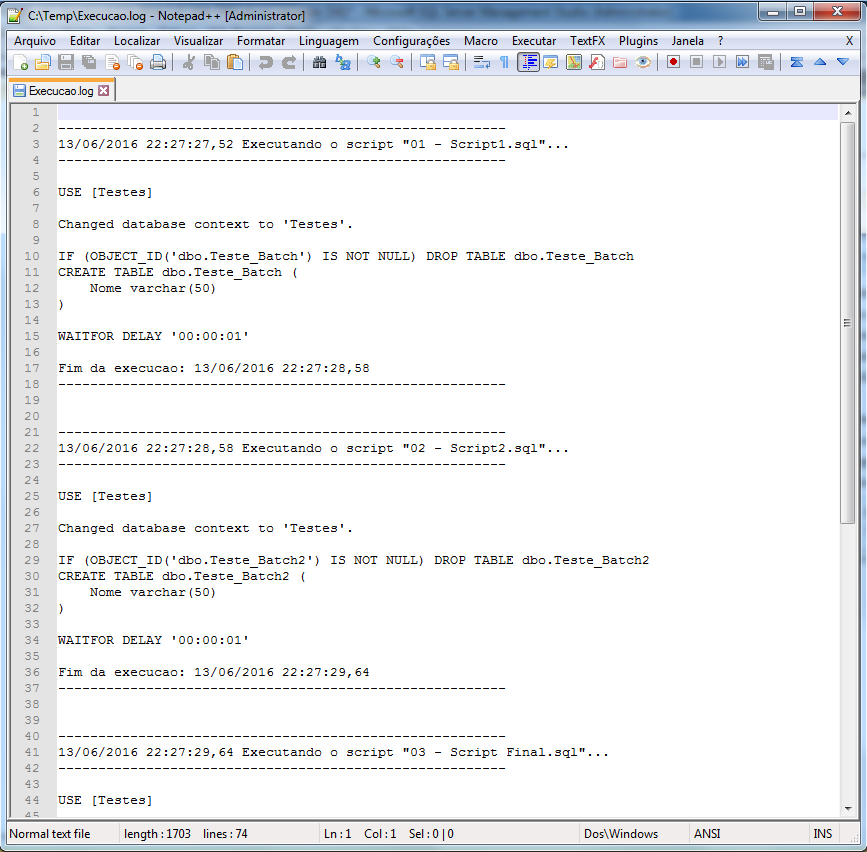

Oracle9i Enterprise Edition Release 9.2.0.6.0 - Production Sqlplus tkyte/tkyte and Settings\tkyte>test.cmd Host echo define x=%NAME% > '&X' from dual Ĭ:\Documents and Settings\tkyte>type off (I'm sorry, the previous message was not clear enough to understand what was inside the trigger body)
#Sql batch script example code
Here's the code that I execute in SQL*Plus Worksheet. So, the code between -STARTS HERE- and -STOPS HERE- is in the trigger body. I added some table creation to complete the example. SELECT, END), but what follows should not be in the These three previous commands are correct (BEGIN, END ) and I also see the command that create the second sequence, the second trigger, the third sequence, the. When I look at the trigger body, the code inside the trigger, I see the code of the trigger (BEGIN. sql file, I create a lot of sequences and triggers.īut when the first trigger is created, I get an error of compilation and everything stop there. I have another file in which I drop and create all the table and everything is fine. In the first trigger body, I should not see the code for the secondSeq and what follows. I get an error in the first trigger body: SELECT SecondSeq.nextval INTO :new.SecondId FROM dual SELECT FirstSeq.nextval INTO :new.FirstId FROM dual ĬREATE TABLE TblSecond( SecondId number ) sql file, and when I created sequence/trigger, something strange happen. So, use &name to get asked each time, &name to get asked once. New 1: select 'foo' from not on subsequent executions

I got prompted the first set echo select '&name' from dual if I use &name edit set echo select '&name' from dual Note that I got prompted again for name - it did not retain the value. rerunning and i set echo select '&name' from dual Note that I used &name in the query - single ampersand. Not sure WHICH behaviour you are looking for - but we can do either or. "i will be prompted for name and title but if I run second time I will not" I am always interested in new challenges so if you need consulting help, reach me at all posts by Rajendra Gupta".but i want that I should be prompt(ed) for the name and title every time."
#Sql batch script example series
I am the creator of one of the biggest free online collections of articles on a single topic, with his 50-part series on SQL Server Always On Availability Groups.īased on my contribution to the SQL Server community, I have been recognized as the prestigious Best Author of the Year continuously in 2019, 2020, and 2021 (2nd Rank) at SQLShack and the MSSQLTIPS champions award in 2020. I published more than 650 technical articles on MSSQLTips, SQLShack, Quest, CodingSight, and SeveralNines. I am the author of the book " DP-300 Administering Relational Database on Microsoft Azure". Hi! I am Rajendra Gupta, Database Specialist and Architect, helping organizations implement Microsoft SQL Server, Azure, Couchbase, AWS solutions fast and efficiently, fix related issues, and Performance Tuning with over 14 years of experience. Let’s understand the PARSEONLY statement behavior using examples.Įxample 1: Default query behavior SQL ServerĮxecute the following T-SQL batch, and it completes all phases of a SQL Query, i.e., Parse compiles and execute. We cannot use any conditional behavior such as Case and IF statements with PARSEONLY SET PARSEONLY OFF: If we have enabled PARSEONLY using SET PARSEONLY ON, we can disable the query execution behavior using SET PARSEONLY OFF SET PARSEONLY ON: We can specify this statement and only parse phase is executed The PARSEONLY statement allows only the Parse phase for T-SQL. We can use the PARSEONLY statement in a query batch, and SQL Server does not compile and execute the statement. We might use multiple batches in a single query session, but these batches are independent of each other. SQL Server processes one batch request at a time. The Go statement works as a batch separator. You might have noticed we use the Go statement for query execution in SQL Server. SQL Server provides PARSEONLY and NOEXEC session-level configuration. We want to prevent such accidental query execution. For example, you specified a drop table statement for dropping a few tables, but if it satisfies certain conditions. You must hit the cancel button to stop this execution, but it might have done damages for you. Suppose you are writing a complicated script and press F5 by mistake. Execute: Once SQL Server completed parse and compilation, SQL Server executes query batch and returns output to the client.During the compilation phase, SQL Server also optimizes the query execution and comes with an optimized execution plan using available indexes and statistics Compile: In this phase, SQL Server checks for the objects, whether they exist or not.In case the query contains multiple errors, it lists all error messages along with the line numbers.


 0 kommentar(er)
0 kommentar(er)
